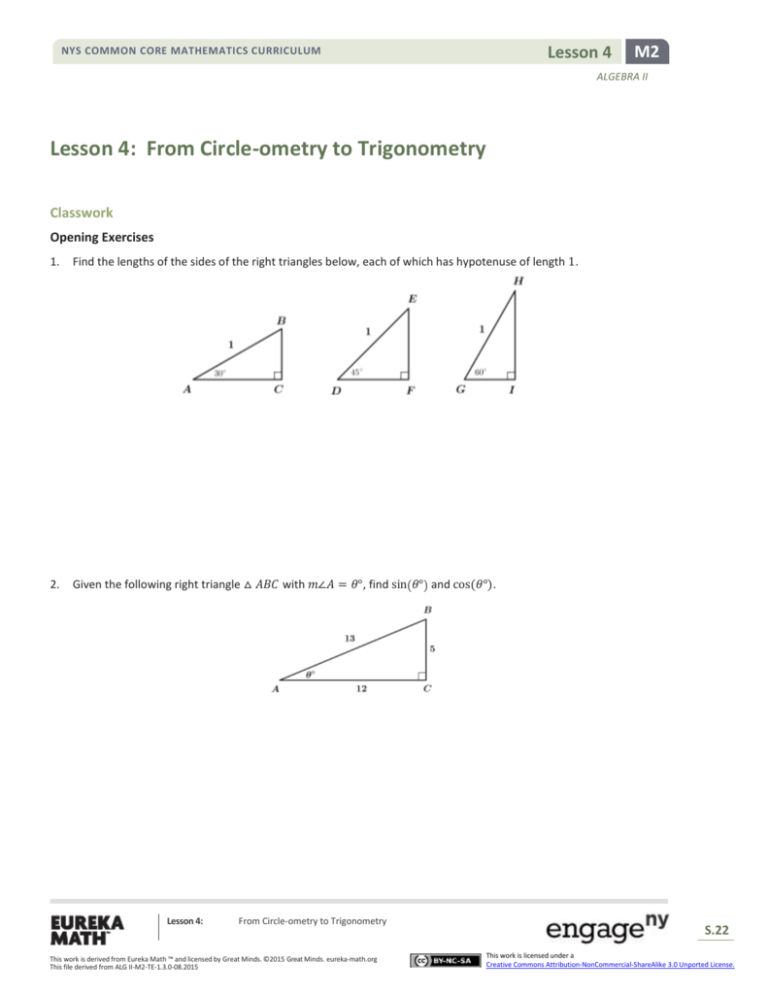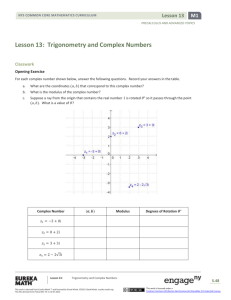Lesson 4 - EngageNY
advertisement

Lesson 4 NYS COMMON CORE MATHEMATICS CURRICULUM M2 ALGEBRA II Lesson 4: From Circle-ometry to Trigonometry Classwork Opening Exercises 1. Find the lengths of the sides of the right triangles below, each of which has hypotenuse of length 1. 2. Given the following right triangle △ 𝐴𝐵𝐶 with 𝑚∠𝐴 = 𝜃°, find sin(𝜃°) and cos(𝜃°). Lesson 4: From Circle-ometry to Trigonometry This work is derived from Eureka Math ™ and licensed by Great Minds. ©2015 Great Minds. eureka-math.org This file derived from ALG II-M2-TE-1.3.0-08.2015 S.22 This work is licensed under a Creative Commons Attribution-NonCommercial-ShareAlike 3.0 Unported License. NYS COMMON CORE MATHEMATICS CURRICULUM Lesson 4 M2 ALGEBRA II Example 1 Suppose that point 𝑃 is the point on the unit circle obtained by rotating the initial ray through 30°. Find sin(30°) and cos(30°). What is the length 𝑂𝑄 of the horizontal leg of our triangle? What is the length 𝑄𝑃 of the vertical leg of our triangle? What is sin(30°)? What is cos(30°)? Lesson 4: From Circle-ometry to Trigonometry This work is derived from Eureka Math ™ and licensed by Great Minds. ©2015 Great Minds. eureka-math.org This file derived from ALG II-M2-TE-1.3.0-08.2015 S.23 This work is licensed under a Creative Commons Attribution-NonCommercial-ShareAlike 3.0 Unported License. NYS COMMON CORE MATHEMATICS CURRICULUM Lesson 4 M2 ALGEBRA II Exercises 1–2 1. Suppose that 𝑃 is the point on the unit circle obtained by rotating the initial ray through 45°. Find sin(45°) and cos(45°). 2. Suppose that 𝑃 is the point on the unit circle obtained by rotating the initial ray through 60°. Find sin(60°) and cos(60°). Example 2 Suppose that 𝑃 is the point on the unit circle obtained by rotating the initial ray through 150°. Find sin(150°) and cos(150°). Lesson 4: From Circle-ometry to Trigonometry This work is derived from Eureka Math ™ and licensed by Great Minds. ©2015 Great Minds. eureka-math.org This file derived from ALG II-M2-TE-1.3.0-08.2015 S.24 This work is licensed under a Creative Commons Attribution-NonCommercial-ShareAlike 3.0 Unported License. NYS COMMON CORE MATHEMATICS CURRICULUM Lesson 4 M2 ALGEBRA II Discussion Exercises 3–5 3. Suppose that 𝑃 is the point on the unit circle obtained by rotating the initial ray counterclockwise through 120 degrees. Find the measure of the reference angle for 120°, and then find sin(120°) and cos(120°). 4. Suppose that 𝑃 is the point on the unit circle obtained by rotating the initial ray counterclockwise through 240°. Find the measure of the reference angle for 240°, and then find sin(240°) and cos(240°). Lesson 4: From Circle-ometry to Trigonometry This work is derived from Eureka Math ™ and licensed by Great Minds. ©2015 Great Minds. eureka-math.org This file derived from ALG II-M2-TE-1.3.0-08.2015 S.25 This work is licensed under a Creative Commons Attribution-NonCommercial-ShareAlike 3.0 Unported License. NYS COMMON CORE MATHEMATICS CURRICULUM Lesson 4 M2 ALGEBRA II 5. Suppose that 𝑃 is the point on the unit circle obtained by rotating the initial ray counterclockwise through 330 degrees. Find the measure of the reference angle for 330°, and then find sin(330°) and cos(330°). Discussion Lesson 4: From Circle-ometry to Trigonometry This work is derived from Eureka Math ™ and licensed by Great Minds. ©2015 Great Minds. eureka-math.org This file derived from ALG II-M2-TE-1.3.0-08.2015 S.26 This work is licensed under a Creative Commons Attribution-NonCommercial-ShareAlike 3.0 Unported License. Lesson 4 NYS COMMON CORE MATHEMATICS CURRICULUM M2 ALGEBRA II Lesson Summary In this lesson we formalized the idea of the height and co-height of a Ferris wheel and defined the sine and cosine functions that give the 𝑥- and 𝑦- coordinates of the intersection of the unit circle and the initial ray rotated through 𝜃 degrees, for most values of 𝜃 with 0 < 𝜃 < 360. The value of cos(𝜃°) is the 𝑥-coordinate of the intersection point of the terminal ray and the unit circle. The value of sin(𝜃°) is the 𝑦-coordinate of the intersection point of the terminal ray and the unit circle. The sine and cosine functions have domain of all real numbers and range [−1,1]. Problem Set 1. Fill in the chart. Write in the reference angles and the values of the sine and cosine functions for the indicated values of 𝜃. Amount of rotation, 𝜽, in degrees Measure of Reference Angle, in degrees 𝐜𝐨𝐬(𝜽°) 𝐬𝐢𝐧(𝜽°) 120 135 150 225 240 300 330 Lesson 4: From Circle-ometry to Trigonometry This work is derived from Eureka Math ™ and licensed by Great Minds. ©2015 Great Minds. eureka-math.org This file derived from ALG II-M2-TE-1.3.0-08.2015 S.27 This work is licensed under a Creative Commons Attribution-NonCommercial-ShareAlike 3.0 Unported License. Lesson 4 NYS COMMON CORE MATHEMATICS CURRICULUM M2 ALGEBRA II 2. Using geometry, Jennifer correctly calculated that sin(15°) = 1 √ 2 − √3 . Based on this information, fill in the 2 chart. Amount of rotation, 𝜽, in degrees Measure of Reference Angle, in degrees 𝐜𝐨𝐬(𝜽°) 𝐬𝐢𝐧(𝜽°) 15 165 195 345 1 3. Suppose 0 < 𝜃 < 90 and sin(𝜃°) = 4. Suppose 90 < 𝜃 < 180 and sin(𝜃°) = 5. If cos(𝜃°) = − 6. Johnny rotated the initial ray through 𝜃 degrees, found the intersection of the terminal ray with the unit circle, and calculated that sin(𝜃°) = √2. Ernesto insists that Johnny made a mistake in his calculation. Explain why Ernesto is correct. 7. If sin(𝜃°) = 0.5, and we know that cos (𝜃°) < 0, then what is the smallest possible positive value of 𝜃? 8. The vertices of triangle △ 𝐴𝐵𝐶 have coordinates 𝐴(0,0), 𝐵(12,5), and 𝐶(12,0). 1 √5 √3 . What is the value of cos(𝜃°)? 1 √3 . What is the value of cos(𝜃°)? , what are two possible values of sin(𝜃°)? a. Argue that △ 𝐴𝐵𝐶 is a right triangle. b. What are the coordinates where the hypotenuse of △ 𝐴𝐵𝐶 intersects the unit circle 𝑥 2 + 𝑦 2 = 1? c. ⃗⃗⃗⃗⃗ to 𝐴𝐵 ⃗⃗⃗⃗⃗ . Calculate sin(𝜃°) and cos(𝜃°). Let 𝜃 denote the number of degrees of rotation from 𝐴𝐶 Lesson 4: From Circle-ometry to Trigonometry This work is derived from Eureka Math ™ and licensed by Great Minds. ©2015 Great Minds. eureka-math.org This file derived from ALG II-M2-TE-1.3.0-08.2015 S.28 This work is licensed under a Creative Commons Attribution-NonCommercial-ShareAlike 3.0 Unported License. Lesson 4 NYS COMMON CORE MATHEMATICS CURRICULUM M2 ALGEBRA II 9. The vertices of triangle △ 𝐴𝐵𝐶 have coordinates 𝐴(0,0), 𝐵(4,3), and 𝐶(4,0). The vertices of triangle △ 𝐴𝐷𝐸 are 𝐴(0,0), 𝐷(3,4), and 𝐸(3,0). a. Argue that △ 𝐴𝐵𝐶 is a right triangle. b. What are the coordinates where the hypotenuse of △ 𝐴𝐵𝐶 intersects the unit circle 𝑥 2 + 𝑦 2 = 1? c. ⃗⃗⃗⃗⃗ to 𝐴𝐵 ⃗⃗⃗⃗⃗ . Calculate sin(𝜃°) and cos(𝜃°). Let 𝜃 denote the number of degrees of rotation from 𝐴𝐶 d. Argue that △ 𝐴𝐷𝐸 is a right triangle. e. What are the coordinates where the hypotenuse of △ 𝐴𝐷𝐸 intersects the unit circle 𝑥 2 + 𝑦 2 = 1? f. Let 𝜙 denote the number of degrees of rotation from ⃗⃗⃗⃗⃗ 𝐴𝐸 to ⃗⃗⃗⃗⃗ 𝐴𝐷 . Calculate sin(𝜙°) and cos(𝜙°). g. What is the relation between the sine and cosine of 𝜃 and the sine and cosine of 𝜙? 10. Use a diagram to explain why sin(135°) = sin(45°), but cos(135°) ≠ cos(45°). Lesson 4: From Circle-ometry to Trigonometry This work is derived from Eureka Math ™ and licensed by Great Minds. ©2015 Great Minds. eureka-math.org This file derived from ALG II-M2-TE-1.3.0-08.2015 S.29 This work is licensed under a Creative Commons Attribution-NonCommercial-ShareAlike 3.0 Unported License.









